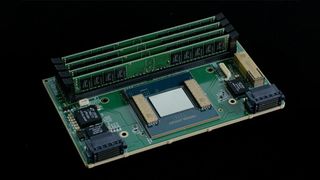
All through its history, MIPS has modified palms and IPOed more than once. However, in a stunning flip of occasions, it has ended up underneath the control of a Chinese company.
Consequently, Chinese companies could now license essential processor structure IP from the corporate and develop their SoCs for varied purposes with no restrictions imposed by the U.S.
Restrictions applied
Starting from 2018, the US government tightened restrictions on direct Chinese investments within the American startups in a bid not to let the Chinese control new technologies.
In addition, select Chinese companies — most notably Huawei Technologies and its subsidiaries — had been included within the US Department of Commerce Entity List, which required them to acquire a particular license to enter applied sciences developed in the US usually.
This prevented Huawei and some others from working with a number of partners within the country. However apparently, because of a collection of acquisitions and licensing agreements, the Chinese high-tech companies can nonetheless entry technologies developed by MIPS, one of many oldest CPU developers from California.
MIPS changes hands
MIPS Computer Systems was established within the early 1980s by a group of scientists from Stanford College, who labored on a venture known as Microprocessor without Interlocked Pipeline Levels (MIPS).
The researchers efficiently developed the MIPS structure and varied cores on its base after which licensed their technologies to different corporations keen to design precise CPUs powered by MIPS.
The company was fairly successful from 1980s to 1992, when it was acquired by Silicon Graphics Inc to develop in-house CPUs and supply greater performance than it was attainable with off-the-shelf choices from opponents.
SGI spun off MIPS in 1998, the company went public and continued with its licensing enterprise model. Whereas not as successful as Arm, MIPS licensed its cores to a variety of corporations, creating chips for an equally wide range of purposes.
Some time in 2013, Imagination Technologies decided that, in a bid to be competitive with Arm, it wanted CPU IP in addition to GPU IP, so it took over MIPS, which is when the turbulence started for the processor company. In early 2017, Apple announced plans to cease using Imagination’s GPU IP inside two years and, whereas not many particulars had been revealed, Creativeness’s inventory plummeted and the board decided to sell the company to a private investor.
China-backed Canyon Bridge acquired ImgTec in late 2017, however in a bid to not provoke the Committee on Overseas Funding in america (CFIUS), a corporation that critiques international investments, MIPS was spun off from ImgTec earlier than the deal was sealed.
China gets MIPS’s technologies
In September 2017, MIPS was taken over by Tallwood Venture Capital managed by Diosdado P. Banatao, who earlier co-founded Moston, Chips and Technologies, and S3 Graphics.
Mr. Banatao transferred MIPS ownership to Wave Computing in mid-2018, which is co-owned by Banatao and Alibaba. Later, Wave Computing transferred MIPS licensing rights to a Samoan-registered firm known as Status Century Funding because of insolvency proceedings. Status Century Investments occurs to be a 100% proprietor of CIP United, a China-registered firm.
CIP United now controls all MIPS licensing rights for all clients in China, Hong Kong and Macau, and has the flexibility to design new spinoff applied sciences primarily based on the MIPS structure, based on Reuters, which cites 4 sources. Amongst others, Huawei Applied sciences is a licensee of CIP and MIPS.
But what about software and manufacturing?
Since CIP United now controls IP developed by MIPS (albeit, only in China), its clients can access it and develop SoCs for varied purposes ranging from sensors and SSD controllers and going all the best way to self-driving vehicles and supercomputer-class CPUs. However, there are two challenges for adopters of the MIPS architecture: software help and production.
The MIPS architecture is not supported by Google’s Android working system on the identical stage as Arm’s architectures. To that end, MIPS licensees both should rely on different OSes or tailor open-source Android for their wants. For many MIPS licensees, lack of Android help is just not an issue since they develop chips for applications that use completely different OSes. In fact, a lot of MIPS-powered gadgets use proprietary software program anyway.
In the meantime, a technology large like Huawei has assets to superior open-source Android in accordance with their needs.
However, Huawei has a special problem. It cannot work with any contract maker of semiconductors that use technologies developed within the USA, which implies all foundries, together with Taiwan Semiconductor Manufacturing Co. (TSMC) in Taiwan in addition to Semiconductor Manufacturing International Co. (SMIC) in China.
Being unable to entry manufacturing makes Huawei’s chip design prowess ineffective. What will probably be fascinating is whether or not the corporate finds a workaround for this conundrum too.
Made in China 2025
Huawei is among the largest high-tech corporations in China, however for the nation’s authorities, the ‘Made in China 2025’ plan is significantly extra essential than a single firm, because it represents a brand new multi-billion trade that doesn’t rely upon international investments or technologies.
The variety of Chinese chip designers skyrocketed from 736 in 2015 to 1,780 in 2017. Many of those corporations want CPU IP and a few is probably not inclined to make use of Arm. For them, MIPS and RISC-V architectures are two pure decisions and MIPS has an edge over RISC-V proper now.
MIPS does have off-the-shelf high-performance CPU cores similar to Arm’s Cortex-A70-series or Neoverse, but it’s attainable to make use of the MIPS structure to construct one thing highly effective sufficient for servers. For instance, China’s Loongson Know-how develops MIPS64 CPUs for consumer gadgets and servers and there are also Inexperienced 500 supercomputers primarily based on MIPS CPUs.
Unrestricted access to MIPS’s CPU and different IP seems to be crucially essential not just for choose corporations, however the whole Made in China 2025 plan.